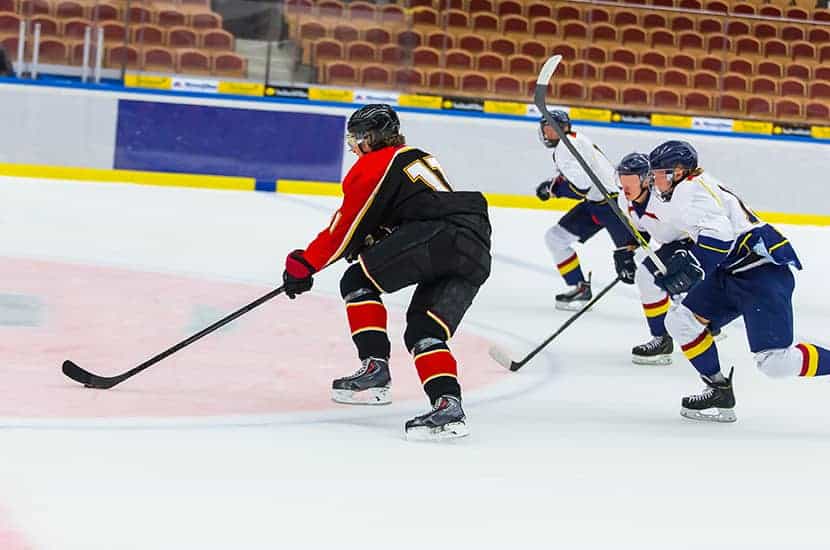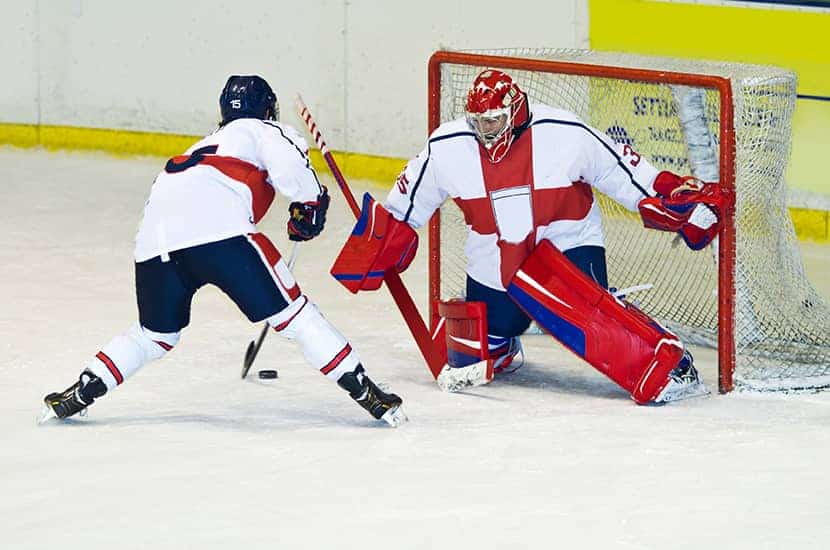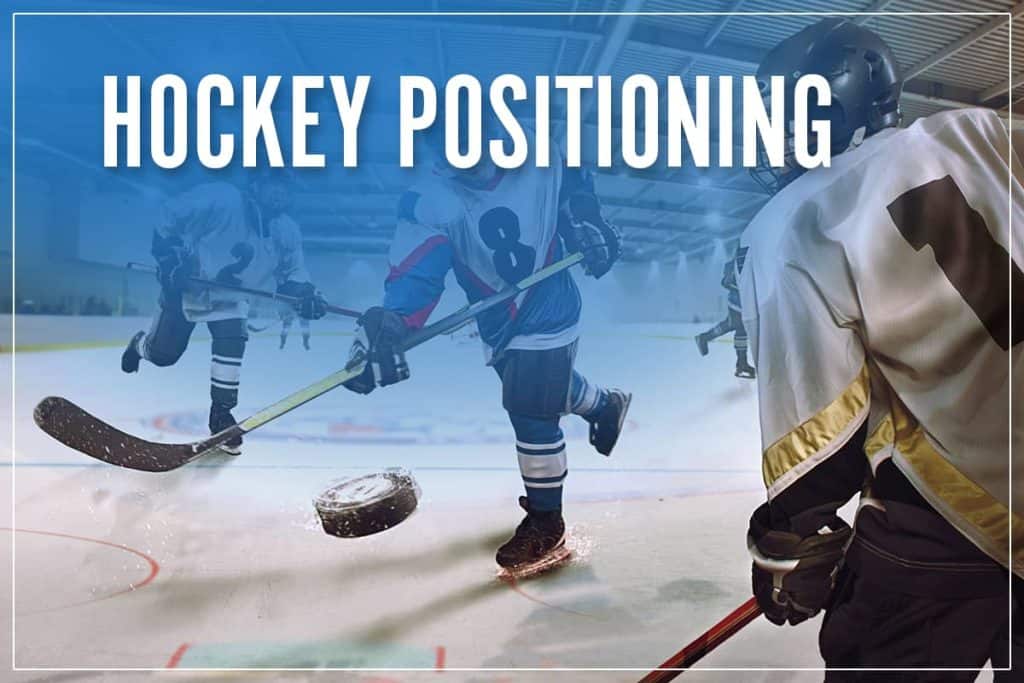To the untrained eye, ice hockey can look like a calamity of players skating all over the place randomly chasing a puck. This could not be further from the truth.
When you watch players in the NHL, they have strict responsibilities to tend to either in the defensive zone or the offensive zone. If you look closely, you can see how they work as a team. If everyone is doing their job, then it should be easier to score goals.
Each position carries its own set of guidelines, so all parts of the ice are covered, and so your teammates always know where you are without having to look. Hockey is a fast game, so the faster you can make a decision, the more goals you and your team will score.
From who protects the defensive zone to goalie skills, we give you a rundown of ice hockey positions – including which may be the best one for you.
Center
The center position is similar to a football Quarterback and is the unofficial hockey team leader on the ice. The center player is allowed to go anywhere they feel they are needed and are responsible for taking the faceoffs.
Goalie
The most recognizable player on the ice, the goalie position keeps the puck out of the net at all costs. Easy to spot from wearing more protective gear than the other players, they stay in front of the net all the time. They are allowed to leave the net whenever they want but their excessive equipment slows them down considerably, making it difficult to return in a hurry.
Right Winger
When facing the opposing net, right wingers will always line up to the right of the center person when taking faceoffs. Ideally, the right winger stays on the right side and the left winger on the left throughout gameplay – also so every team mate always knows where they are.
Left Winger
The mirror image of the right winger, a left winger lines up and stays on the left side of the ice when facing the opposing goal – sticking with the opposing team’s right defenseman. The left wing position should be played by an offensive player who shoots left-handed—vice versa for the right side.
Right Defense
The right defenseman is one of two defensive positions (the other being the left defenseman). Assigned to the right side of the ice, they keep the puck away from their goalie and out of their defensive zone as much as possible. It’s preferable that the right defenseman be a right-handed shot.
Left Defense
Covering the other half of the ice in the left side defensive zone is the left defenseman. Ideally, a left-handed shot, they must work with the right defenseman to cover their own defensive zone and get the puck away from their own net as quickly as possible.
Forward
This refers to the three forward positions on the ice: center, right wing and left wing. These players are responsible for attacking, advancing the puck deep into the offensive zone and hopefully score more goals than the other team. If you are a beginner at skating, you may want to refer to these articles to get more information What To Wear Ice Skating Indoors And Outdoors, How To Ice Skate and learn about the difference between figure skates and hockey skates here.
Hockey Player Roles

Playmaker
A playmaker refers to a player with a knack for making something out of nothing. When their hockey team is down on their luck, this is the person they turn to, able to lift their team’s spirits with one great play at the perfect time. An example of this would be Sydney Crosby. His overall skill has the potential to affect an entire game’s momentum.
Sniper
A player known for their shot – whether it be a slap shot, wrist shot or snap shot, you can bet your bottom dollar it will find its target. Usually awe-inspiring goals leaving goalies stunned, their ability to hit small targets is unmatched. Alex Ovechkin is known for his deadly accuracy. However, he could also be considered a playmaker.
Grinder
This title applies aptly to hockey more so than other sports, signifying a deep conviction to get the win no matter what. They help inspire the team by giving 110% every shift all season long. It’s common for grinders to play injured, sick or even through personal crises, but it’s all for the team. In a sport known for its grinders, this is the most appreciated title and the hardest to earn.
Enforcer
The enforcer has the most obvious name and definitely not the player you want to run into on the ice. Unofficially, the enforcer is there to protect the playmakers and snipers from getting targeted by the other team. If you look up “Enforcer” in the hockey dictionary, you’ll probably see a picture of Zdeno Chara. While not the most skillful players, they’re worth their weight in gold…and most of them weigh A LOT.
Power Forward
Power forward is another complimentary title; a player who is not only a forward, but is strong like a defenseman. Most forwards tend to be speedy with soft hands and duck and dodge their way around bigger players. A power forward doesn’t shy away from a bit of contact – and probably looks forward to it.
Two-Way Forward
This is a very coveted moniker, essentially saying that as a forward, you are so athletically gifted that you’re able to help out on defense as well, in the same shift. Technically all hockey players are two-way. A defenseman can score goals, and a forward can stop them. But at the pro levels, they are groomed to excel in one area or another. A two-way forward can accomplish two jobs at the same time, at an elite level. To ensure you have the best hockey skates, check out our post about Best Hockey Skates For Beginners.
Goalie Styles And Skills

In ice hockey, opposing players are trained to find ways to get the puck past you any way they can. To fight this, goalies have developed systems to cover all areas of the net as efficiently as possible.
Butterfly
The name refers to the position of the goalie’s legs. While on their knees, they extend their legs to either side and block any shot that’s low enough to hit their pads. A very athletic approach, it requires them to be up and down a lot throughout the game. However, it is the most popular style among NHL goalies.
Stand-Up
Almost the opposite of the butterfly is the stand-up style. Taller goalies use this mainly since they typically can’t get up as fast as shorter goalies. The stand-up style relies heavily on fast footwork with more lateral movement across the net to cover all low areas without going down. The stand-up method is very effective against blocking high shots since a taller goalie covers the whole upper half of the net with their hands up. Check out our tips for lacing hockey skates here.
Hybrid
The hybrid method is a combination of both styles. This requires a very quick ice hockey goalie to go from a kneeling position for low shots to a standing position for high shots. A hybrid goalie uses their body to stop pucks – by getting your largest body mass in front of the puck, you will cover more net area. If you are looking for the best hockey equipment to take your game to the next level, read our review of the Best Hockey Helmets here. Also, check out our article about Best Hockey Gloves for on the ice here.
What Position Should You Play In Hockey
Your position will be based on your skillset. Forwards tend to be quicker and more agile, covering the most ice during a shift. Particularly the center position – this player must offer their support no matter where it’s needed.
If you’re a good shooter, play winger. Giving you ample opportunity to use your accuracy and score goals for your team, you don’t need to be as fast as the center position, but it helps. What is icing in hockey? Click here to find out more.
Playing defense demands impeccable backward skating technique – NHL defensemen can skate backward just as fast as they skate forward. It also helps to be either large or very strong. Ice hockey is a rough sport, and defense is the roughest position. It’s your job to protect your entire defensive zone and keep the puck out of your own end at all costs.
All these positions require a lot of practice, so check out our hockey puck and hockey stick reviews next to choose you kit! If you are a fan of figure skating and would like to get the best skates, read our reviews of the Best Figure Skates next. Also, check out our review of the Best Ice Skates For Beginners.
Frequently Asked Questions
What Are The 6 Positions In Hockey?
The six positions in hockey are center, right wing, left wing, right defense, left defense and goalie. It’s common in the NHL to specialize in one of these positions and play it for your entire career. Each position has its own duties, for example sticking with the defensive zone, and when all positions’ responsibilities are met, teams start winning.
How Do You Learn Basic Hockey Positions?
The best way to learn basic hockey positions is to get out there and play. Sign up for a local league that plays once a week throughout the winter. This will give you a chance to hang out with other like-minded ice hockey players from whom you can learn everything from passing lanes to playing defense.
What Is The Hardest Position In Hockey?
The hardest position in hockey is the goalie. As a team’s last line of defense against the other team, it’s a very tough position mentally. Although several positions are playing defense, a goalie is all alone in net, and every goal that gets scored will be on the same goalie. It’s easy for people in this position to blame themselves and get negative very quickly. The best goalies are gifted athletes but also masters of their own domain.
What Does F Mean In Hockey?
When a player has an F beside their name on the roster, it’s referring to their position on the ice. F stands for forward players, D stands for defensive players and G stands for goalie. It’s only during practice and throughout gameplay when teams decide on the specific position within the forwards that a player will play.
What Is The Most Important Position In Hockey?
The most important position in hockey is, again, the goalie. While there are many forwards and many defenders, there is only one goalie. Your team needs to have a strong goalie if they want to compete in the playoffs. Also, other positions get time to rest on the bench as they rotate with their teammates. The goalie stays out there all alone for the entire game as the last line of defense against the other team.
Conclusion
There are not many people participating at once in hockey compared to other sports like football and soccer. It’s easy to get to know the hockey positioning and what each person does, for example sticking with the defensive zone or playing down the left side. Becoming good at one of these positions is another story, requiring hard work and dedication plus a high level of athletic ability if you want to climb the ranks. If you’re playing with your buddies in a beer league, then we recommend you try all positions at least once, even goalie. This will give you a great appreciation for the game and a better understanding of what your teammates are going through – ultimately making you a better player.

